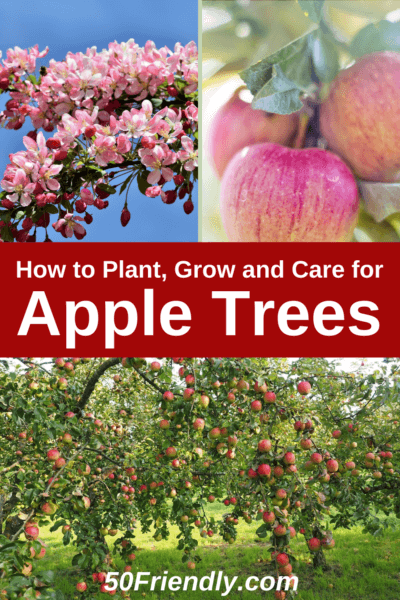How to Grow Apple Trees – The Easy Way
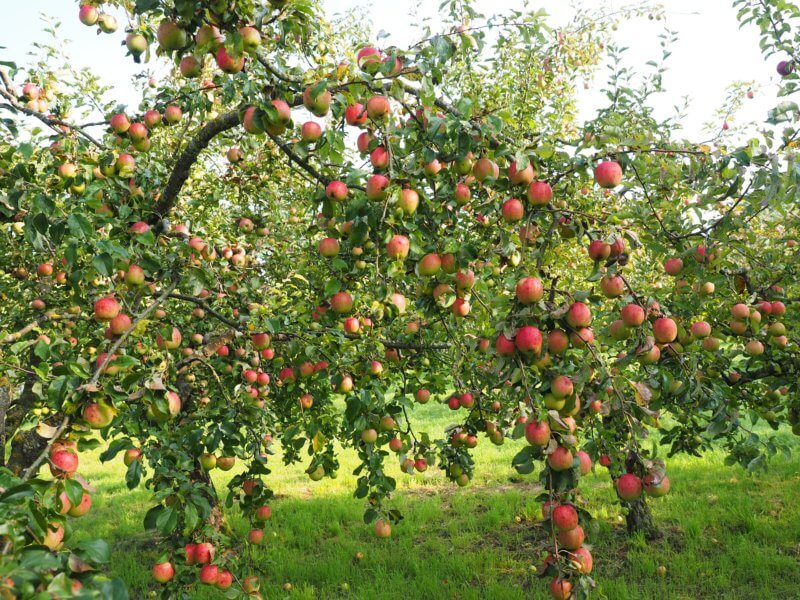
Apples – How to Plant, Grow, and When to Harvest
How to Grow Apple Trees – The Easy Way. Apple trees are a great fruit to grow in your orchard or backyard. I mean seriously … the blooms in the spring are simply beautiful and have such a sweet-smelling fragrance to them. And who doesn’t love a sweet juicy apple as a snack, or in a salad, or in a dessert?
But having an apple tree doesn’t mean you can just set it and forget it – they need the care to keep giving you those delicious crispy fruits year after year. They need sun and water, need a neighboring tree to cross-pollinate with, need pest control, and need to be pruned. Does this sound hard?
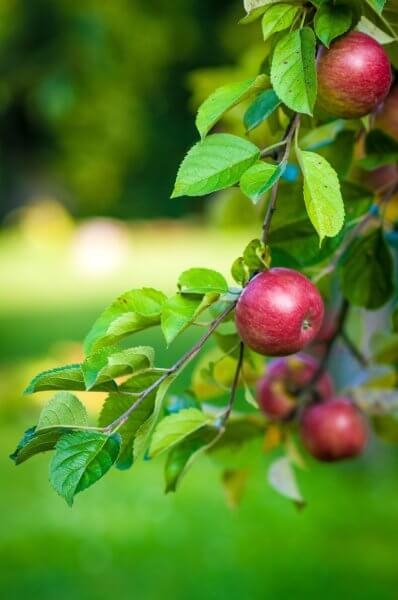
Well, it can be a daunting task if you have a lot of apple trees in your orchard or garden, but it’s definitely not hard. For us, we have Fuji, Jonathan, Yellow Delicious, and Red Delicious in garden number 1. And have Yellow Delicious, Red Delicious, Red Tangy, and Yellow Transparent in garden number 2. They keep us busy in early spring and in the fall, but in-between they’re pretty easy to care for.
If apples are a fruit you’re looking to have in your garden, and if you follow the guidelines and tips below – you should have a nice yield of apples in the fall. So what are you waiting for? Read on
PLANTING NEW APPLE TREES
When is the best time to plant apple trees?
The best time to plant apple trees is in the spring. But if you live in an area where fall and winter weather is mild and moist, planting in the fall can be very successful as well. And take note, most apple trees will start to produce fruit in their 3rd or 4th year.
Where to plant apple trees?
The best exposure for apples is a north side of a house or the north side of your orchard.
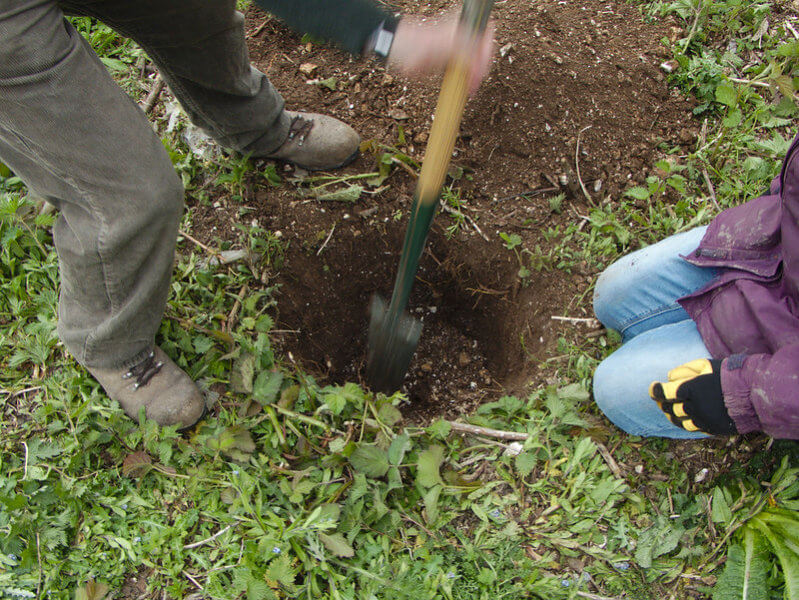
How to plant apple trees?
Once you purchase the tree, protect it from injury, drying out, freezing, or overheating. If the roots have dried out, you’ll need to soak them in water for 24 hours before planting.
Remove all weeds and the grass in a 4-foot diameter circle. Dig a hole 2 feet deep and twice the diameter of the root system, and lay some loose soil on the bottom and around the inner circle. Place your tree in the hole and make sure the grafted union of the tree is at least 2 inches above the soil line. Spread the tree roots on the loose soil and add soil around the roots. As you add the soil, firm it around the roots to remove air pockets. Do not add any fertilizer to the hole or roots as you may cause them to burn.
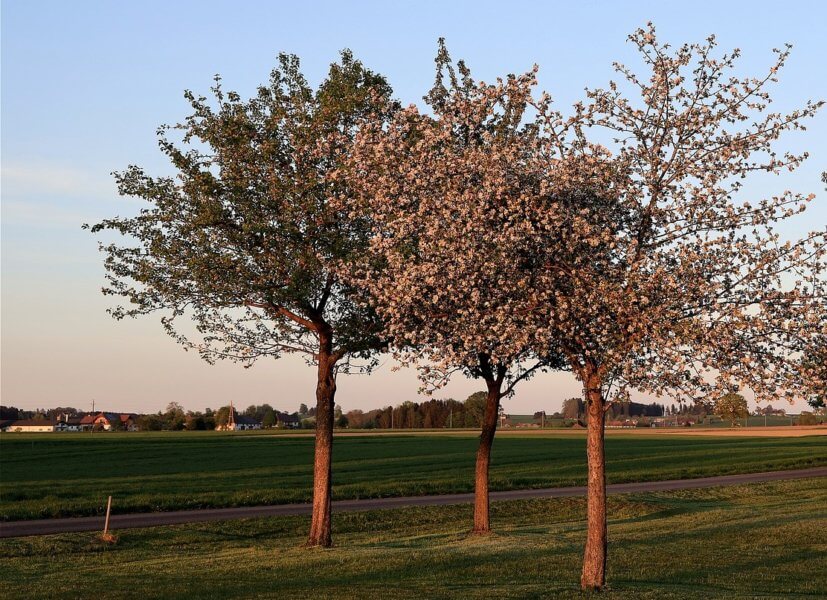
Can you plant just one apple tree?
In order to get apples from your tree, you are going to have to plant a neighboring apple tree. So make sure to plant a couple of varieties so the flowers get pollinated. If you only want to grow one apple variety, have a crab apple tree nearby as they make very good pollinizers.
How do you take care of an apple tree for the first year?
Make sure you’ve planted the tree in well-drained soil and then water it deeply twice a week during any dry spells in the summer. Older trees have deeper roots and can access water deep in the soil – but they’ll still need to be watered, just not deeply.
APPLE TREE CARE
When can I start fertilizing my young apple tree?
Apple trees require nitrogen, phosphorus, and potassium. So after three weeks from planting, fertilize the apple tree by spreading a ½ pound of 20-10-10 in a circle 18-24 inches (the 20 represents a higher nitrogen ratio to fuel healthy growth).
You can also give them a boost of magnesium by spreading some Epsom Salt in the circle, which will help them yield larger, sweeter, and more fruits.
Should I spray my apple tree?
During the apple tree’s dormant stage, spray dormant oil to control overwintering pests like scale, aphid, and mite larvae and eggs. Keep in mind the dormant stage for an apple tree is when temps fall below 45° F, which is during late fall and winter. If the spray is applied too early, it will simply dissipate and become ineffective when the insects attack. If it’s applied too late, the pests enter and eat inside the fruit where they are protected from sprays.
PRUNING APPLE TREES
Pruning is done to help the tree develop a strong framework to a size and shape of your liking. It is also necessary to maintain tree health and to increase fruit production for your orchard. The best time to prune the tree is in the winter or very early spring. If your apple tree has reached its desired size, you can also prune in summer to hinder any future growth.
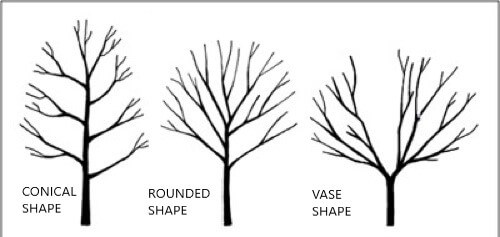
How do I prune my newly planted apple tree?
You can train your young tree to achieve a CONICAL SHAPE where you have ONE central leader on the tree, with some side branches; a more ROUNDED TREE where you have a central leader but with other supporting leaders as well; or a VASE SHAPE TREE with an open center.
Pruning established apple trees
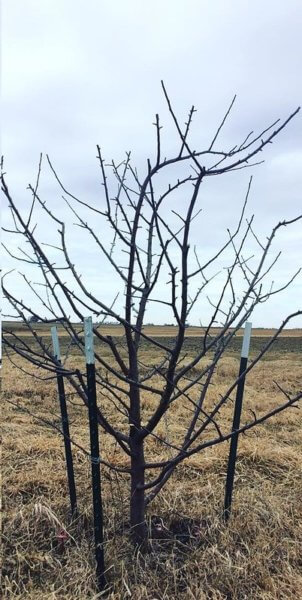
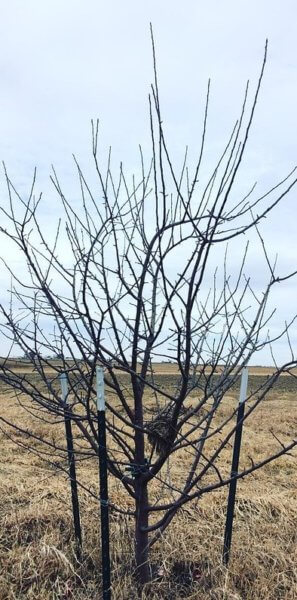
I personally prefer the VASE SHAPE TREE framework (with an open center) of branches on the tree, meaning it should have more volume at the base than at the top. The reason for this is because it increases air circulation to the center of the tree while allowing more sunlight to go towards the fruit. The vase form is the most common tree shape used for most fruit trees, especially in backyard gardens. Being cup-shaped, it has increased branching towards the top and more space below. We have also found the trees are much easier to maintain when they’re shaped this way – and no complaints here with our yearly abundance of fruit.
7 Steps to Pruning an Overgrown Apple Tree
How to identify growth buds and flower buds on an apple tree
A GROWTH BUD produces a branch but no fruit. They are much smaller than flower buds, grow tight into the branch or stem, and are slender and more pointed. Prune above the growth buds to shape the tree.
A FLOWERING BUD will produce a flower which then becomes an apple. These buds are larger, plumper than growth buds, and grow on spurs which are short, stubby branches where the fruit is produced. Prune the flower buds to adjust the yield of the tree.
7 STEPS TO PRUNING AN OVERGROWN APPLE TREE
So, here are the 7 steps to pruning an overgrown apple tree. And while pruning like this may seem severe, what you’re actually doing is prepping the tree for some great results in all new growth and better fruit. So best to do it now rather than later.
1) make sure to clean away and remove any dried-up apples, fallen leaves and plant debris around the tree.
2) remove all dead or diseased branches.
3) snip away the next 3 growths as they will only pull the energy from your tree and will never bear fruit.
SUCKERS – are branches growing from the base of the tree
WHORLS – are branches that grow from and encircle another branch
WATER SPROUTS – are thin branches that usually grow straight upright
4) Remove any branches within about 4 feet of the ground.
5) Prune any downward-facing branches as they will be unproductive, and remove any branches that cross or rub against larger branches as they’ll only damage the scaffold branches.
6) Prune away any major side branches extending from the leader (the central trunk), as they will become competing branches that will prevent the openness of the tree.
7) Lastly, thin all interior branches so that sunlight can reach all the fruits. Each branch should sit at a good 45 degrees angle from the leader.
WHEN TO HARVEST APPLES
When to harvest apples – how to know when apples are ready to be picked. Apples should be harvested when they are mature but before their peak of ripeness. Here are the:
3 WAYS TO TEST AN APPLES READINESS
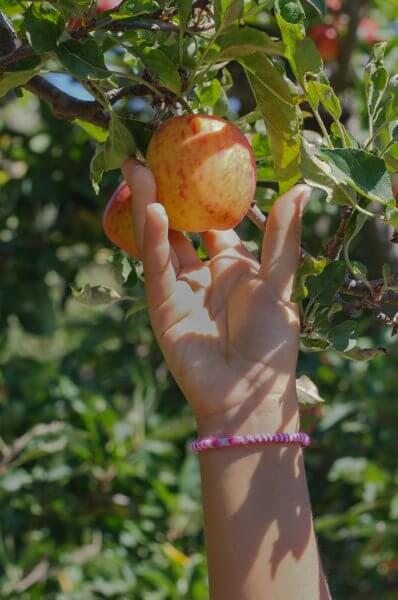
1) While the apple is still on the tree, hold one in your hand, lift it towards the stem, and twist. If it easily comes off then it is ready. If you have to tug on it to get it off, then they are not ready to be harvested.
2) Pick an apple and slice it open to see what color the seeds or pips are. A ripe apple will have dark brown pips.
3) Mature apples are firm, crisp, and juicy with good color and a developed flavor characteristic of the variety. They should not be sour (unless it’s a crab apple or a tart variety) and starchy. Keep in mind if they are mealy – then they’re overripe.
HOW TO STORE APPLES
When we bought our property, the owner told me that it’s best to harvest the apples after the first frost, as long as the temperature doesn’t get below 24 degrees. She said to wait until the afternoon when the fruit had completely thawed, then pick them off the tree. If you do it while they may still be a bit frozen, the apples will bruise and you won’t be able to use them.
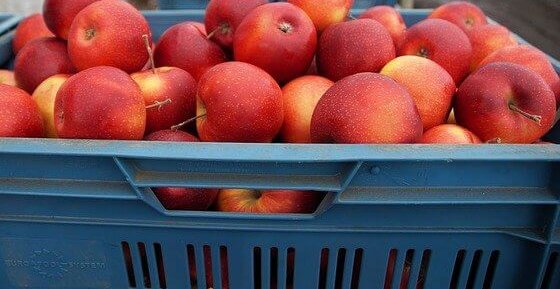
Storing Apples – check your batch for any damaged ones and pull them out before storage. Damaged apples give off ethylene more quickly and can cause your entire batch of apples to spoil.
Place the undamaged apples in boxes or baskets lined with foil or plastic and keep them in a room where the temperature is 32 degrees, especially if you plan on keeping them for 6 months or so. The colder the temperature the better – apples stored at 50 degrees will ripen four times faster than those at 32 degrees.
And there you have it, the low down on Apples – How to Plant, Grow, and When to Harvest. I hope you find the above information useful, and with your efforts may your trees produce an abundance of apples in the future. Enjoy 🙂 AND AS ALWAYS – HAPPY GARDENING
